ect HONDA ODYSSEY 2003 RB1-RB2 / 3.G Service Manual
[x] Cancel search | Manufacturer: HONDA, Model Year: 2003, Model line: ODYSSEY, Model: HONDA ODYSSEY 2003 RB1-RB2 / 3.GPages: 415, PDF Size: 5.28 MB
Page 44 of 415
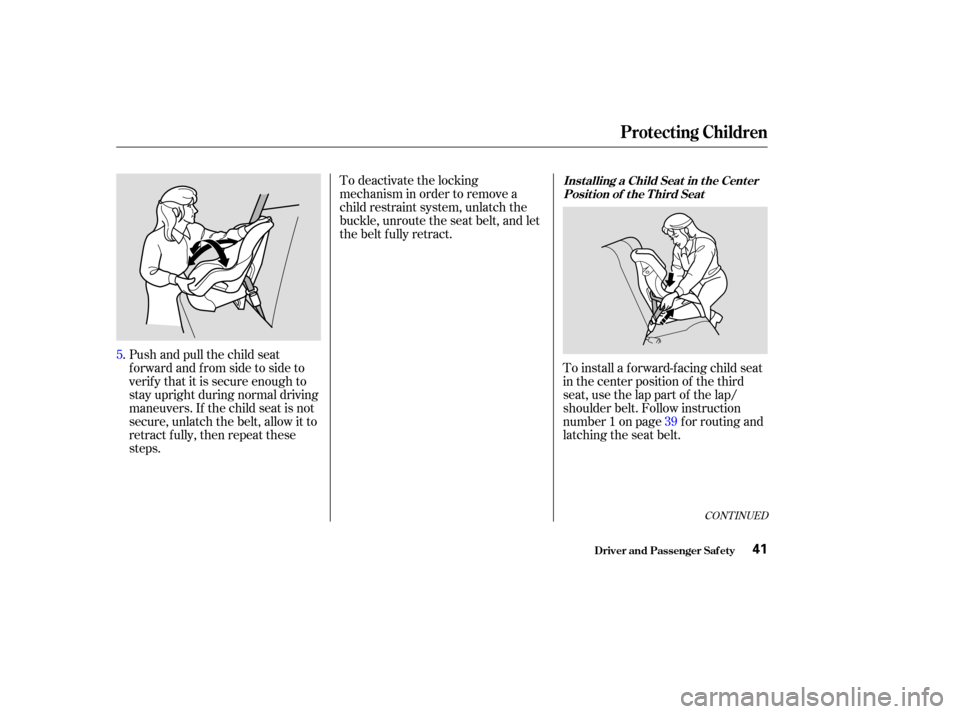
To deactivate the locking
mechanism in order to remove a
child restraint system, unlatch the
buckle, unroute the seat belt, and let
the belt fully retract.
Push and pull the child seat
f orward and f rom side to side to
verif y that it is secure enough to
stay upright during normal driving
maneuvers. If the child seat is not
secure, unlatch the belt, allow it to
retract f ully, then repeat these
steps. To install a forward-facing child seat
in the center position of the third
seat, use the lap part of the lap/
shoulder belt. Follow instruction
number 1 on page f or routing and
latching the seat belt.
5.
39
CONT INUED
Inst alling a Child Seat in t he Cent erPosition of the T hird Seat
Protecting Children
Driver and Passenger Saf ety41
Page 45 of 415

Then pull hard on the loose end of
thebelttoremovetheanyslack(it
may help to put weight on the child
seat while pulling on the belt).
Finally, f ollow instruction number 5
on page to verify that the child
seat is secured.When a child reaches the
recommended weight or height limit
for a forward-facing child seat, the
child should sit in the back seat on a
booster and wear a lap/shoulder belt.
We recommend that the child use a
booster seat until the child is tall
enough to use the seat belt without a
booster.
The f ollowing pages give
instructions on how to check proper
seat belt f it, what kind of booster
seat to use if one is needed, and
important precautions f or a child
who must sit in the f ront seat.
41
Protecting L arger Children
Protecting Children
Driver and Passenger Saf ety42
Allowing a larger child to sit
improperly in the front seat can
result in injury or death if the
passenger’s front airbag inflates.
If a larger child must sit in front,
make sure the child moves the
seat as far back as possible,
uses a booster seat if needed,
and wears the seat belt properly.
Page 46 of 415
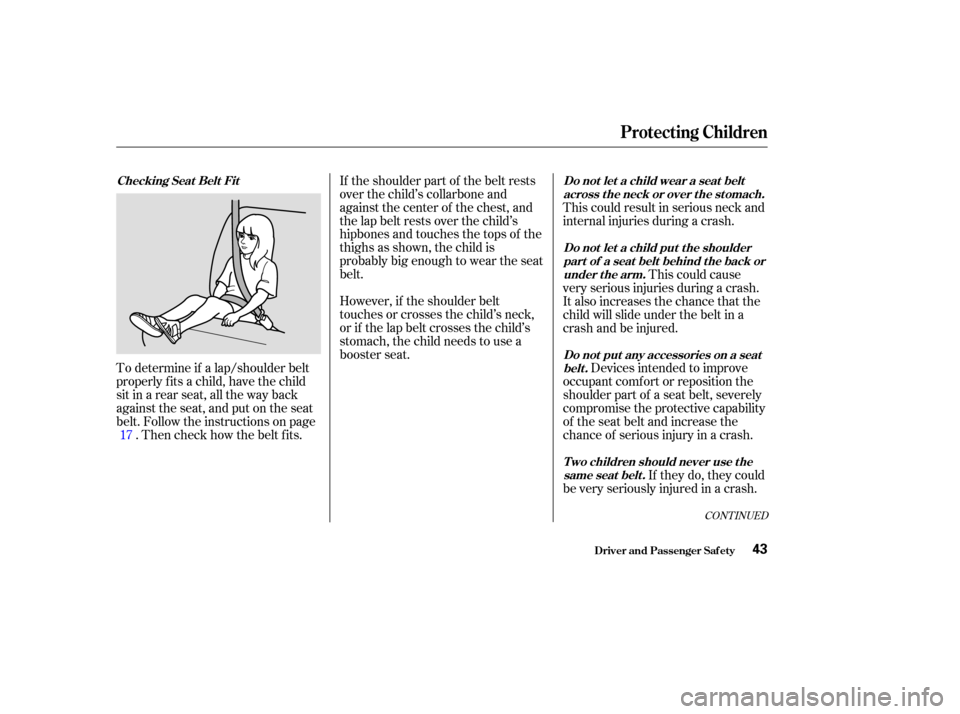
To determine if a lap/shoulder belt
properly f its a child, have the child
sit in a rear seat, all the way back
against the seat, and put on the seat
belt. Follow the instructions on page. Then check how the belt f its. If the shoulder part of the belt rests
over the child’s collarbone and
against the center of the chest, and
the lap belt rests over the child’s
hipbones and touches the tops of the
thighs as shown, the child is
probably big enough to wear the seat
belt.
However, if the shoulder belt
touchesorcrossesthechild’sneck,
or if the lap belt crosses the child’s
stomach, the child needs to use a
booster seat.
This could result in serious neck and
internal injuries during a crash.
If they do, they could
be very seriously injured in a crash. Devices intended to improve
occupant comf ort or reposition the
shoulder part of a seat belt, severely
compromise the protective capability
of the seat belt and increase the
chance of serious injury in a crash. This could cause
very serious injuries during a crash.
It also increases the chance that the
child will slide under the belt in a
crash and be injured.
17
CONT INUED
Checking Seat Belt Fit Do not let a child wear a seat belt
across t he neck or over t he st omach.
T wo children should never use t hesame seat belt .
Do not put any accessories on a seat
belt.
Do not let a child put the shoulder
part of a seat belt behind t he back orunder t he arm.
Protecting Children
Driver and Passenger Saf ety43
Page 47 of 415
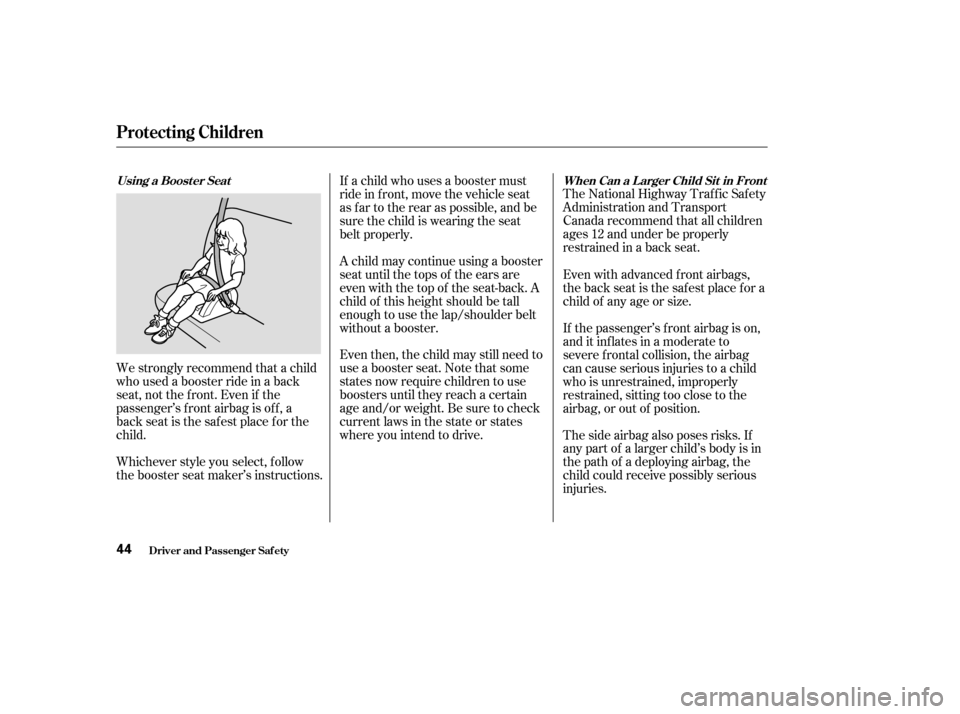
The National Highway Traffic Safety
Administration and Transport
Canada recommend that all children
ages 12 and under be properly
restrained in a back seat.
We strongly recommend that a child
whousedaboosterrideinaback
seat,notthefront.Evenif the
passenger’s f ront airbag is of f , a
back seat is the safest place for the
child.
Whichever style you select, f ollow
the booster seat maker’s instructions. If a child who uses a booster must
ride in f ront, move the vehicle seat
as far to the rear as possible, and be
sure the child is wearing the seat
belt properly.
A child may continue using a booster
seat until the tops of the ears are
even with the top of the seat-back. A
child of this height should be tall
enough to use the lap/shoulder belt
without a booster.
Even then, the child may still need to
use a booster seat. Note that some
states now require children to use
boosters until they reach a certain
ageand/orweight.Besuretocheck
current laws in the state or states
where you intend to drive.
If the passenger’s f ront airbag is on,
and it inflates in a moderate to
severe f rontal collision, the airbag
can cause serious injuries to a child
who is unrestrained, improperly
restrained, sitting too close to the
airbag, or out of position.
The side airbag also poses risks. If
any part of a larger child’s body is in
the path of a deploying airbag, the
child could receive possibly serious
injuries. Even with advanced front airbags,
the back seat is the safest place for a
child of any age or size.
When Can a Larger Child Sit in Front
Using a Boost er Seat
Protecting Children
Driver and Passenger Saf ety44
Page 48 of 415

If you decide that a child can saf ely
ride up f ront, be sure to:Caref ully read the owner’s manual
and make sure you understand all
seat belt instructions and all saf ety
inf ormation.
Move the vehicle seat to the rear-
most position.
Have the child sit up straight, back
against the seat, and feet on or
near the f loor.
Check that the child’s seat belt is
properly positioned and secured.
Physically, a child must be large
enough f or the lap/shoulder belt to
properly f it over the hips, chest, and
shoulder (see pages and ). If
the seat belt does not f it properly,
the child should not sit in the f ront.
To saf ely ride in f ront, a child must
be able to f ollow the rules, including
sitting properly and wearing the seat
belt properly throughout a ride.
Of course, children vary widely. And
while age may be one indicator of
when a child can saf ely ride in the
f ront, there are other important
f actors you should consider.
Supervise the child. Even mature
children sometimes need to be
reminded to f asten the seat belts
or sit properly. Remind the child not to lean
toward the door.
17 42Physical Size
Maturity
Protecting Children
Driver and Passenger Saf ety45
Page 49 of 415
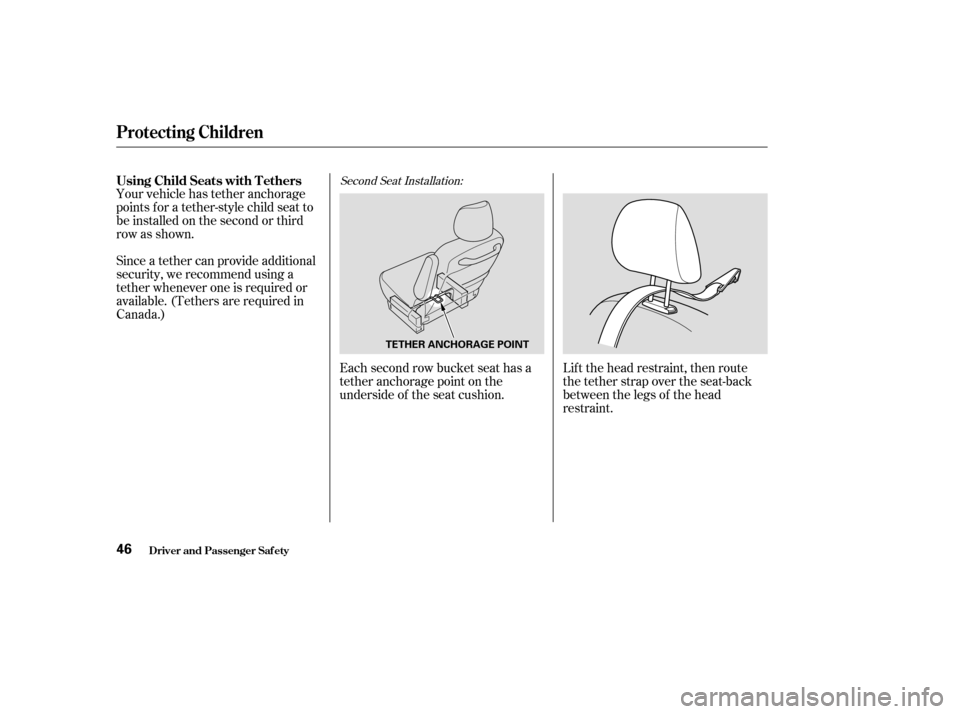
Second Seat Installation:
Lift the head restraint, then route
the tether strap over the seat-back
between the legs of the head
restraint.
Your vehicle has tether anchorage
points f or a tether-style child seat to
be installed on the second or third
row as shown.
Since a tether can provide additional
security, we recommend using a
tether whenever one is required or
available. (Tethers are required in
Canada.)
Each second row bucket seat has a
tether anchorage point on the
underside of the seat cushion.
Using Child Seats with T ethers
Driver and Passenger Saf ety
Protecting Children
46
TETHER ANCHORAGE POINT
Page 50 of 415
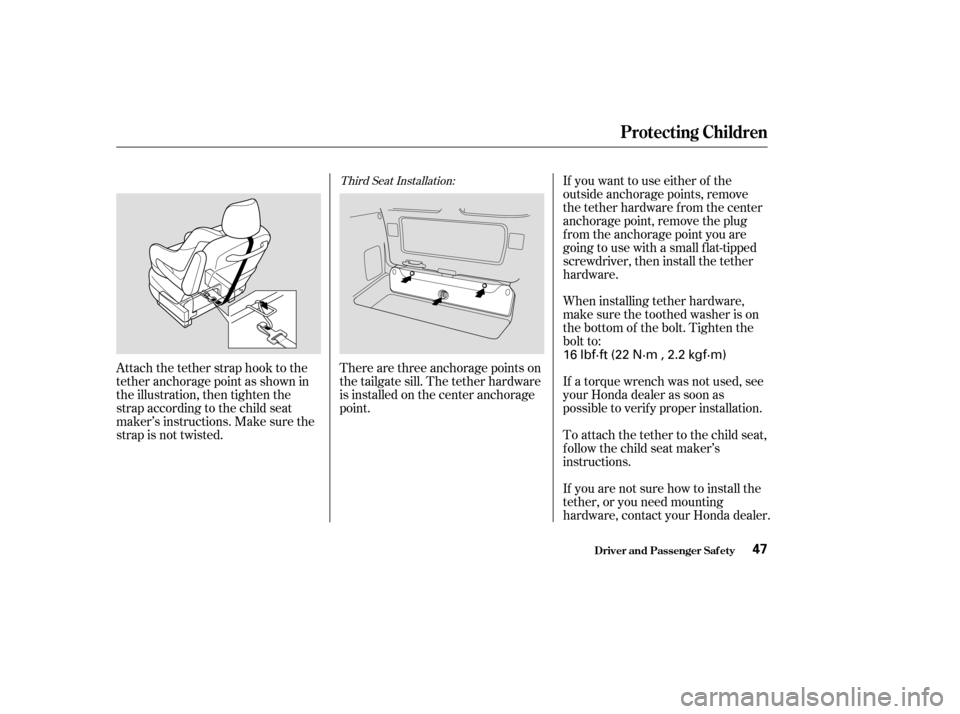
Third Seat Installation:
If you are not sure how to install the
tether, or you need mounting
hardware, contact your Honda dealer. To attach the tether to the child seat,
f ollow the child seat maker’s
instructions. If a torque wrench was not used, see
your Honda dealer as soon as
possible to verif y proper installation. When installing tether hardware,
make sure the toothed washer is on
the bottom of the bolt. Tighten the
bolt to:
Attach the tether strap hook to the
tether anchorage point as shown in
the illustration, then tighten the
strap according to the child seat
maker’s instructions. Make sure the
strap is not twisted. There are three anchorage points on
the tailgate sill. The tether hardware
is installed on the center anchorage
point.If you want to use either of the
outside anchorage points, remove
the tether hardware f rom the center
anchorage point, remove the plug
f rom the anchorage point you are
going to use with a small f lat-tipped
screwdriver, then install the tether
hardware.
Protecting Children
Driver and Passenger Saf ety47
16 lbf·ft (22 N·m , 2.2 kgf·m)
Page 51 of 415
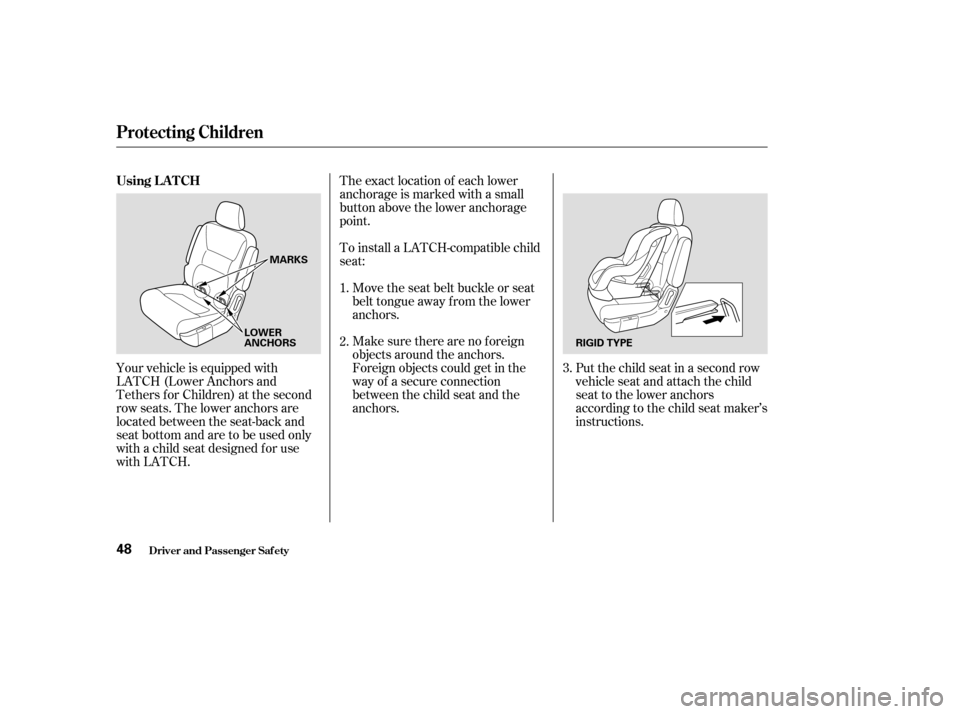
Put the child seat in a second row
vehicle seat and attach the child
seat to the lower anchors
according to the child seat maker’s
instructions.
Your vehicle is equipped with
LATCH (Lower Anchors and
Tethers f or Children) at the second
row seats. The lower anchors are
located between the seat-back and
seat bottom and are to be used only
with a child seat designed f or use
with LATCH. Make sure there are no f oreign
objects around the anchors.
Foreign objects could get in the
way of a secure connection
between the child seat and the
anchors. Move the seat belt buckle or seat
belt tongue away f rom the lower
anchors.
To install a LATCH-compatible child
seat: The exact location of each lower
anchorage is marked with a small
button above the lower anchorage
point.
1.
2.
3.
Using L A T CH
Protecting Children
Driver and Passenger Saf ety48
RIGID TYPE
LOWER
ANCHORS MARKS
Page 52 of 415
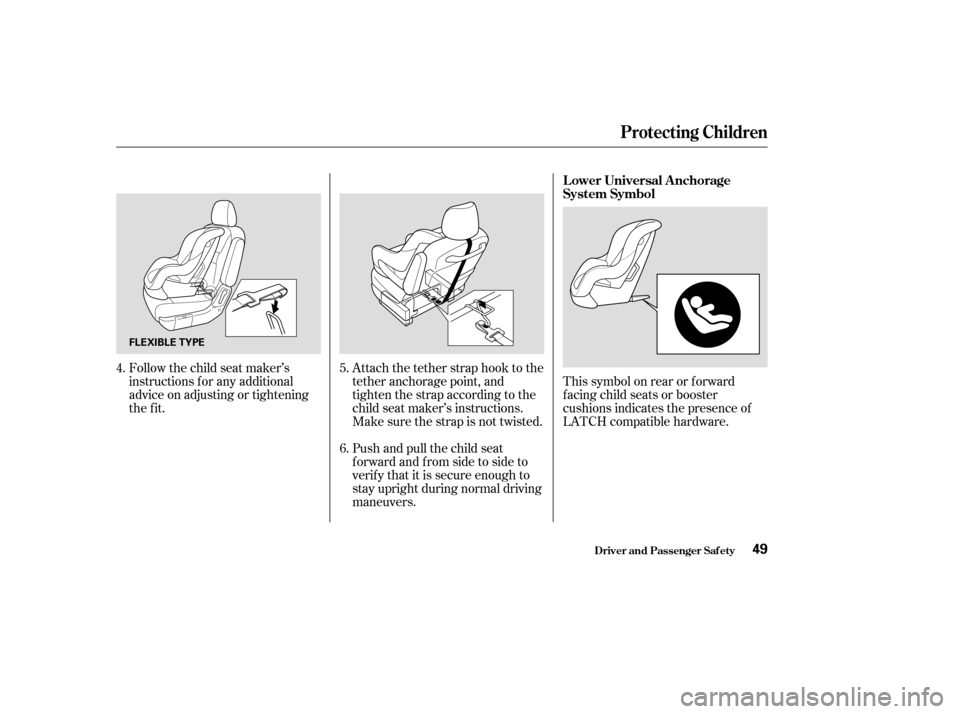
Follow the child seat maker’s
instructions f or any additional
advice on adjusting or tightening
the fit.Push and pull the child seat
f orward and f rom side to side to
verif y that it is secure enough to
stay upright during normal driving
maneuvers. Attach the tether strap hook to the
tether anchorage point, and
tighten the strap according to the
child seat maker’s instructions.
Make sure the strap is not twisted.This symbol on rear or f orward
f acing child seats or booster
cushions indicates the presence of
LATCH compatible hardware.
4.
5.
6.
Protecting Children
Driver and Passenger Saf ety
L ower Universal Anchorage
System Symbol
49
FLEXIBLE TYPE
Page 55 of 415

The tensioners are designed to
activate primarily in f rontal collisions.
The tensioners are independent of
the airbag system, so they can be
activated during a collision that
might not cause the airbags to
deploy. In this case, the airbags
would not be needed but the
additional seat belt tension can be
helpf ul.
The tensioners will be activated in a
collision severe enough to cause the
f ront airbags to inf late.
When the tensioners are activated,
the seat belts will remain tight until
they are unbuckled in the normal
way.The SRS indicator light will
come on if there is a
problem with your automatic seat
belt tensioners (see page ).
For added protection, the f ront seat
belts are equipped with automatic
seat belt tensioners. When activated,
the tensioners immediately tighten
the belts to help hold the driver and
a f ront passenger in place. 59
A utomatic Seat Belt T ensioners
Additional Inf ormation About Your Seat Belts
Driver and Passenger Saf ety52